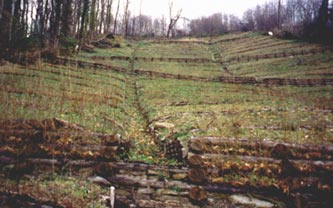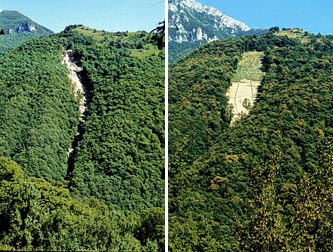 COUNTRY OF ORIGIN
COUNTRY OF ORIGIN• Italy
Soil Bioengeneering
Introduction
Soil Bioengineering (“slope and river bioengineering stabilization”) is a branch of technical science that studies ways of using living plants, parts of plants or different plant associations as construction material, often in conjunction with nonliving material such as stone, earth, wood, and steel. It seeks to achieve hydro-geological soil consolidation by establishing a blanket of vegetation to retain rainfall, protect soil from wind erosion and provide it with efficient drainage. Bioengineering is primarily concerned with the stabilization and environmental regeneration of slopes and riverbanks subject to landslides. However, it also has an important added value: it respects the landscape and the ecosystem.
The origins and development of bioengineering are relatively recent, dating back to the first decades of the 1900s. The first documented experiences, including accounts, reports and publications, were produced by technicians in the German-speaking areas of the Alps, in Austria, Germany, and Switzerland. Forestry technicians and public administration inspectors began to experiment, evaluate and classify intervention typologies and criteria based on the use of living material, such as plants, and/or natural material, such as wood or stone.
Although from a scientific and bibliographical point of view this branch of engineering is relatively recent, in actual fact many of the techniques and the empirical bases for the use of living vegetable material in consolidating and regenerating unstable soils date back to much earlier times and probably represented, from the very beginning, efficient instruments for mountain economy and agriculture.
Another important function of bioengineering is the reduction of vulnerability in soil exposed to recurrent climatic disasters, such as landslides and flooding. These events have a disastrous impact on development, halting progress and obliging institutions to redirect available funds to deal with emergency situations. According to the International Federation of the Red Cross and Red Crescent Societies, in the 1990s the world was subject to three times as many natural disasters as in the 1960s, while over the last five years emergency funds have dwindled by 40%. More than 90% of all natural disaster victims in the world live in developing countries. These soil management techniques can, therefore, have a significant impact in areas exposed to natural disasters.
Bioengineering was first applied in the forestry sector but has subsequently been used to protect soil in mountain areas, blend infrastructure into the landscape, and regenerate quarries, waste disposal sites and other degraded areas. In the last few decades these techniques have been much promoted in Italy, at first in the Alps and then in the Apennines and Mediterranean areas. At present they represent a valid alternative to traditional engineering projects, even if, in some circumstances, classical civil engineering methods cannot be abandoned. Legislation has been introduced to provide incentives for this type of systemization, not only because it brings great ecological benefits and regenerates the landscape, but also because it is an economically viable alternative to traditional interventions.
In Italy, this branch of technical science has seen considerable development thanks to AIPIN, the Italian association for bioengineering, which promotes and disseminates these techniques through conferences, technical tours, capacity building courses in schools, publications, and research projects. Bioengineering has been extensively used in Austria, Germany, and Switzerland from the beginning of the century, and in Central and southern European countries from the 1980s.
DOWNLOAD THE BROCHURE PDF
Spanish (1.3 MB)English (0.6 MB)







